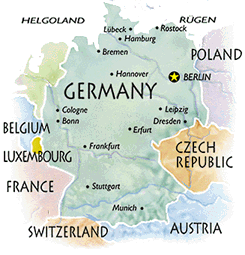
 With stunning landscapes, exciting cities and priceless art treasures, as well as
rapidly developing tourist facilities in its five eastern states, unified Germany offers
more than ever before.
With stunning landscapes, exciting cities and priceless art treasures, as well as
rapidly developing tourist facilities in its five eastern states, unified Germany offers
more than ever before.
Points of Interest
Area: 137,838 square miles (slightly smaller than Montana). Population: 84,068,000
(Berlin, 3,478,000; Hamburg, 1,704,000; Munich, 1,251,000; Cologne, 966,000). Language:
German.
Highlights
Berlin,
again the capital, is a center of art and culture. Visit the west for thriving nightlife,
shopping on the famed Kurfürstendamm and landmarks such as the Reichstag and Kaiser
Wilhelm Memorial Church. Go to the east and stroll the wide Unter den Linden Boulevard and
see the new Potsdamer Platz complex. Explore the Pergamon Museum and the restored Nikolai
Quarter with its townhouses and romantic restaurants. The Bertolt Brecht Museum will
reopen this year for the 100th anniversary of the playwright's birth.
Sixteen miles away is Potsdam, famous for the Sanssouci and Cecilienhof palaces and Royal Gardens.
Dresden is regaining its reputation as Germany's most beautiful city. The Baroque Zwinger Palace contains three art museums; the Semper Oper is a neoclassical gem; and the Frauenkirche cathedral is being restored. Nearby is Leipzig, a city of commerce and culture, where Johann Sebastian Bach was choir director at St. Thomas Church.
Hannover will host more than 155 countries during Expo 2000. Visitors here will enjoy the Royal Gardens of Herrenhausen and Maschsee lake.
Rostock, the largest Baltic harbor town, incorporates Warnemünde, a seaside resort. Lübeck's old district is known for its great churches and Gothic brick architecture.
Münster, a city of old churches and burgher houses, is in Westphalia, the northwestern land of romantic, moated castles and lakes.
Bremen is a terminus of the Fairy Tale Road; a monument to the Grimm Brothers delights visitors.
Bonn, on the Rhine, is still the seat of government. It was the birthplace of Ludwig van Beethoven. In Düsseldorf, Germany's fashion capital, you can stroll the elegant Königsallee, and take in the atmosphere of this art and fashion center.
Cologne is a university town with a must-see Gothic cathedral (the cornerstone was set 750 years ago). Numerous museums include the Wallraf-Richartz (old masters), the Ludwig (modern art), Roman Germanic and the Chocolate Museum. Trier, on the Moselle, is the oldest town in Germany, featuring spectacular Roman architecture. The Rhine vineyards, as well as those of the Moselle, the Saar and the Ruwer, are famous for fine wines. The Rhine is a favorite, of course, for cruises.
Frankfurt, cosmopolitan center of business and finance on the river Main, also hosts excellent opera, concerts and ballet.
Heidelberg, celebrated in The Student Prince, has world-famous castle ruins. Baroque Würzburg owes its fame in part to the genius of Balthasar Neumann, architect of the Residenz. Nuremberg, known for toys and its annual Christmas Market, was immortalized in Wagner's opera Die Meistersinger. Rothenburg ob der Tauber is a preserved medieval town with nooks and crannies, alleyways, old townhouses and magnificent edifices.
In Augsburg, Jakob Fugger, patrician founder of a merchant dynasty, established the world's first social housing settlement in 1510. Stuttgart, a historic university town, is home to Mercedes-Benz, Porsche, Bosch and its eponymous ballet. Freiburg, gateway to the Black Forest, includes a splendid cathedral among its outstanding buildings. From Regensburg, the intact medieval city on the Danube, warm-weather cruises go to Walhalla, the German Temple of Fame.
Munich, fun-loving capital of Bavaria, has a flair for fashion and gemŸtlichkeit, especially at Oktoberfest.


